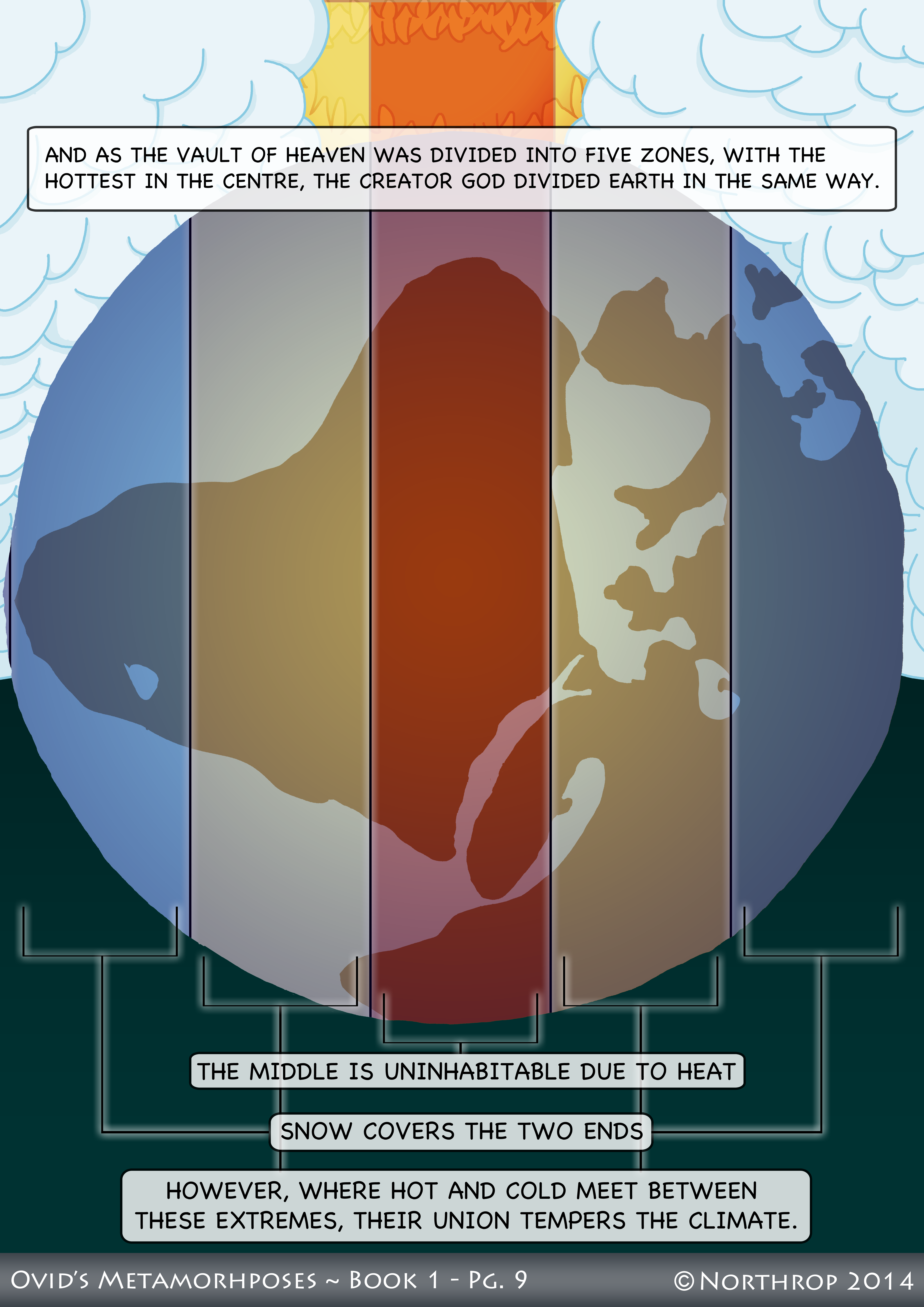Met. 1.45-51 – The Five Zones
UTQUE DUAE DEXTRA CAELUM TOTIDEMQUE SINISTRA
PARTE SECANT ZONAE (QUINTA EST ARDENTIOR ILLIS)
SIC ONUS INCLUSUM NUMERO DISTINXIT EODEM
CURA DEI, TOTIDEMQUE PLAGAE TELLURE PREMUNTUR.
QUARUM QUAE MEDIA EST NON EST HABITABILIS AESTU;
NIX TEGIT ALTA DUAS; TOTIDEM INTER UTRUMQUE LOCAVIT
TEMPERIEMQUE DEDIT MIXTA CUM FRIGORE FLAMMA.
AND AS TWO ZONES ON THE RIGHT OF HEAVEN AND THE SAME ON THE LEFT
CUT IT INTO PARTS (THE FIFTH IS HOTTER THAN THESE)
SO THE GOD’S CARE MARKS THE BOUND WEIGHT* WITH THE SAME NUMBER,
AND AS MANY REGIONS ARE PRESSED ONTO THE WHOLE EARTH.
OF WHICH THAT IN THE MIDDLE IS NOT HABITABLE DUE TO HEAT;
DEEP SNOW COVERS TWO; HE PLACES AS MANY BETWEEN THE OTHERS
AND THE FLAMES MIXED WITH COLD MAKE THEM TEMPERED.
And so we discover the ancient theory of the zones. It takes a well travelled society to recognise that temperate Europe is bordered by extreme cold (the arctic) on one side, and extreme heat (in the equator) on the other. It takes a brilliant mind to reason that the whole arrangement must be mirrored. Such as brilliant mind belonged to… someone. It’s hard to say where the theory started. Strabo says it was Parmenides; Plutarch says Thales or Pythagoras. At any rate, Aristotle has the oldest account of it we still possess. [I edited this bit after originally, incorrectly attributing the theory to Aristotle. Thanks for catching that, Max! – C.] However, while Ovid probably did read some works of Aristotle at one point, the language he uses here seems to follow his closer predecessor, Vergil. Vergil, of Aeneid fame, depicted the five zones in his Georgics (Book 1.231-56), a four book-long poem ostensibly designed to teach agricultural practices. Richard Thomas, in his commentary (1988: pp. 107-12), has pointed out their similarity to the work of the polymath Ertosthenes, who promoted Aristotlean geography. Eratosthenes (c. third century BCE) was head of the Library of Alexandria, the greatest depository of human knowledge in the world (until the Romans accidentally burnt it to the ground in the first century BCE). His theories of geography helped shape the ancient understanding of the world and the cosmos. The really interesting thing about him is that he published his ideas not only in prose, but also in poetry, creating beautiful pieces of Greek verse to explain cutting-edge scientific ideas. The five zones theory is laid out in his poem Hermes, dedicated to the god of the same name (Roman name: Mercury). His poetry is a shining example in a long tradition of ancient scientific poetry, including Lucretius’ De Rerum Natura, a Latin poem dedicated to particle physics. It was this tradition into which Vergil, at least ostensibly, inserted his Georgics, and which Ovid draws on heavily for his depiction of the creation.
The Georgics is quite a great read, if you get the chance. While the effectiveness of it as a manual for farmers is dubious, Vergil collected a vast array of agricultural, meteorlogical, geographical and even mythological material to create a stunning portrait of rural Italy and the Earth itself. It is a masterpiece of the genre of “didactic poetry”, that is, poems at least pretending to teach something. Ovid used it as a model for his own didactic poem, the Ars Amatoria, or Art of Love, in which he cheekily drew on political, historical and even mythological material to paint a stunning portrait of Rome and its erotic opportunities. The project was tongue-in-cheek and humorous (although the emperor Augustus didn’t see it that way – that’s a story for another day), but showed Ovid’s devotion to Vergil, even while he made jokes out of his poetic style. The lessons Ovid learned in writing the Ars, which was one of the last poems he published before the Metamorphoses, come back strongly in this poem, and with them come references to Vergil’s Georgics, which will continue throughout. If you plan to take on the Georgics, be sure to read it along with Thomas’ commentary (Cambridge Greek and Latin Classics, AKA, “Green and Yellow” series).
* i.e. the weighty Earth, which was just bound into the shape of a globe.

I think if we look at Strabo II.2.2, we might find that Parmenides first suggested the idea of the klimatic zones!
Hmm.. yes, you’re right, that is what Strabo says. However, Jones’ Loeb of Strabo notes that Plutarch attributes the theory to Thales and Pythagoras. This is the problem with establishing originators of ideas: there are so many different accounts! As far as I know, Aristotle’s is the first extant account we have, but you’re right, he probably didn’t originate the idea as I suggested. I’ve fixed the post to better reflect the ambiguity…
The five zones are also found in the Somnium Scipionis in Cicero’s Republic.